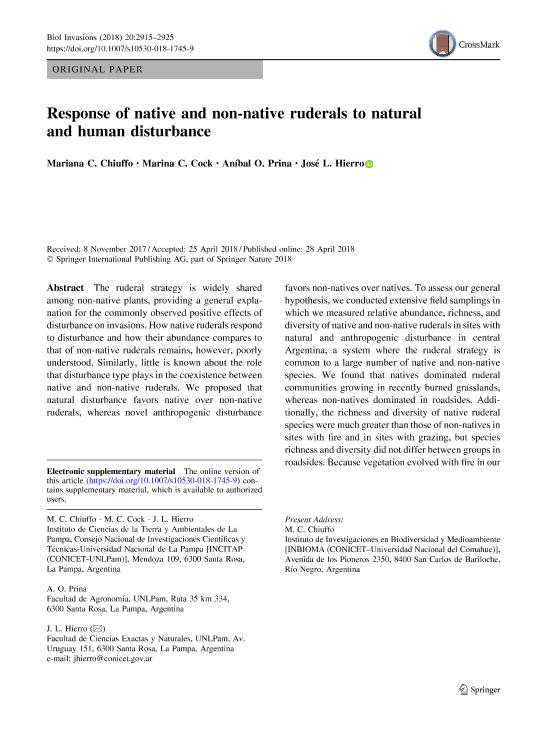Artículo
Response of native and non-native ruderals to natural and human disturbance
Fecha de publicación:
10/2018
Editorial:
Springer
Revista:
Biological Invasions
ISSN:
1387-3547
Idioma:
Inglés
Tipo de recurso:
Artículo publicado
Clasificación temática:
Resumen
The ruderal strategy is widely shared among non-native plants, providing a general explanation for the commonly observed positive effects of disturbance on invasions. How native ruderals respond to disturbance and how their abundance compares to that of non-native ruderals remains, however, poorly understood. Similarly, little is known about the role that disturbance type plays in the coexistence between native and non-native ruderals. We proposed that natural disturbance favors native over non-native ruderals, whereas novel anthropogenic disturbance favors non-natives over natives. To assess our general hypothesis, we conducted extensive field samplings in which we measured relative abundance, richness, and diversity of native and non-native ruderals in sites with natural and anthropogenic disturbance in central Argentina, a system where the ruderal strategy is common to a large number of native and non-native species. We found that natives dominated ruderal communities growing in recently burned grasslands, whereas non-natives dominated in roadsides. Additionally, the richness and diversity of native ruderal species were much greater than those of non-natives in sites with fire and in sites with grazing, but species richness and diversity did not differ between groups in roadsides. Because vegetation evolved with fire in our system and, in contrast, the construction and maintenance of roads is recent in it, these results support our hypothesis. Our work indicates that the ruderal strategy does not seem to suffice to explain why disturbance facilitates invasions. According to our data, species origin interacts with disturbance type to determine dominance in communities with coexisting native and non-native ruderals.
Archivos asociados
Licencia
Identificadores
Colecciones
Articulos(INCITAP)
Articulos de INST.D/CS D/L/TIERRA Y AMBIENTALES D/L/PAMPA
Articulos de INST.D/CS D/L/TIERRA Y AMBIENTALES D/L/PAMPA
Articulos(INIBIOMA)
Articulos de INST. DE INVEST.EN BIODIVERSIDAD Y MEDIOAMBIENTE
Articulos de INST. DE INVEST.EN BIODIVERSIDAD Y MEDIOAMBIENTE
Citación
Chiuffo, Mariana Cecilia; Cock, Marina Cecilia; Prina, Anibal Oscar; Hierro, Jose Luis; Response of native and non-native ruderals to natural and human disturbance; Springer; Biological Invasions; 20; 10; 10-2018; 2915-2925
Compartir
Altmétricas




